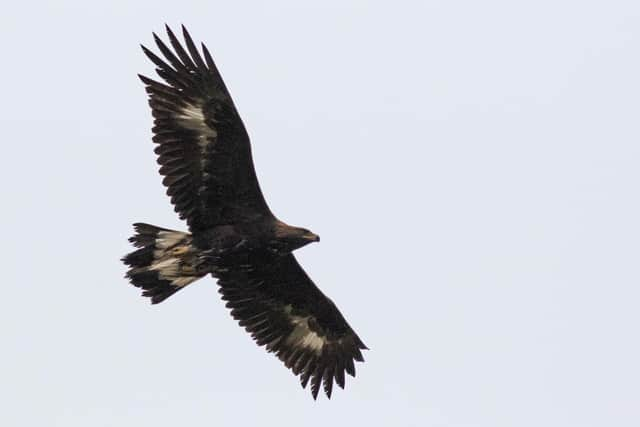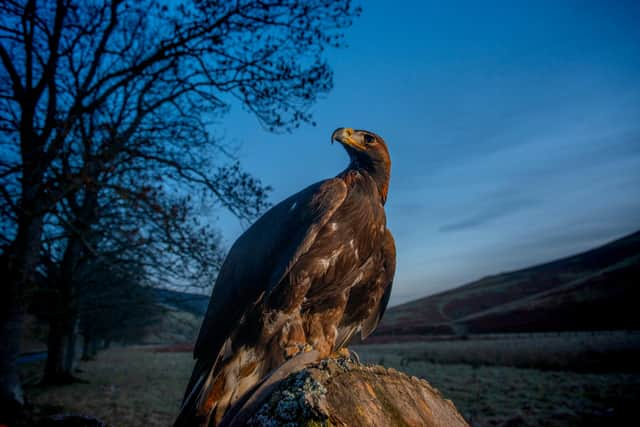Golden eagles: why young birds from the isles are flying the nest and moving to the south of Scotland
With a wingspan stretching more than 2m wide, the massive birds are skilled flyers that can reach speeds of 200mph when diving for prey.
So why have seven adolescent golden eagles hitched a lift on a ferry and taken a 300-mile road trip?
Advertisement
Hide AdAdvertisement
Hide AdIt’s all because of an innovative new scheme being tested out by a pioneering Scottish conservation project, which is working to bring back the species to the southernmost parts of the country.


In a first for raptor reintroduction work in the UK, young golden eagles that have already learnt to fly have been taken from their home territory and relocated to boost a struggling population hundreds of miles away.
The move is part of the South of Scotland Golden Eagle Project, which has been working to rebuild a viable population of golden eagles across Dumfries and Galloway and the Scottish Borders, where numbers had dropped to around two to four pairs – way below the 16 pairs scientists believe the local habitat can support.
The initiative had already successfully released 12 birds, collected as flightless chicks from nests across the Highlands and Islands – a technique widely used for raptor conservation programmes worldwide.


Now another seven older birds, aged between six months and three years old, have been freed and are settling in at their new home.
It’s the first time sub-adults birds have been used in a bird of prey reintroduction scheme in the UK.
It brings the total number of birds reintroduced through the project to 33 since 2018 – the highest number recorded in the area since the early 19th century.
The new youngsters were carefully captured from islands in the Outer Hebrides, which are home to one of the highest densities of golden eagles in Europe.
Advertisement
Hide AdAdvertisement
Hide AdThe birds were then transported south and released at a secret location in the southern uplands of Scotland.
The project team is continuing to monitor the progress of the latest arrivals and hope they will breed in the area.
If they do, this could be ground-breaking for the project and for raptor conservation schemes across the globe.
South of Scotland Golden Eagle Project manager Dr Cat Barlow said: “This new novel-research licence has provided a significant boost in our efforts to ensure golden eagles truly flourish in southern skies.
“Though it is still early days, this is the first in the UK to trial this approach as part of raptor reinforcement.
“This could be a ground-breaking technique for the global conservation management of golden eagles and other raptors.
“We will continue to monitor these birds to see if they settle, thrive and breed in the south of Scotland, which will be the real measure of success.”
Scotland’s environment minister Mairi McAllan added: “The success of this project can be traced back to 2007 – golden eagles faced extinction from southern Scotland for a number of different reasons and the Scottish Government made a commitment to achieve positive change.
Advertisement
Hide AdAdvertisement
Hide Ad“Thanks to the close partnership-working between conservationists and land managers in the south of Scotland, the financial support from sponsors and the world-leading techniques employed by the project, there are now more golden eagles in southern Scotland than there has been for hundreds of years, with birds even being seen in northern England.
“Scotland was one of the first countries to recognise the twin crises of nature-loss and climate change, and this project shows what we can achieve with determined efforts to restore our lost biodiversity.”
NatureScot chief executive Francesca Osowska said: “This ground-breaking project has accomplished so much over just a few years, bringing a viable population of golden eagles back to south Scotland and inspiring other similar initiatives around the world.
“Particularly during the twin crises of climate emergency and biodiversity-loss, it’s wonderful to see a success like this.
“Golden eagles are a vital part of Scotland’s wildlife, and we’re passionate about returning them to places where they used to thrive.
“This is brilliant partnership-working and a great support for the local green economy.”
Andrew MacNair, head of marketing at CalMac Ferries, which supported the careful transportation of the birds, said: “We are truly honoured to have been able to support the South of Scotland Golden Eagle Project’s ground-breaking research.
“As well as global environmental and economical threats such as climate change, Scotland continues to face its own environmental challenges, and we all have a role to play in protecting it for future generations to enjoy.”
Advertisement
Hide AdAdvertisement
Hide AdThe golden eagle is the national bird of Germany, Austria, Mexico and Kazakhstan, as well as Scotland.
But despite its iconic status, the species is absent across much of its historical range here.
Estimates suggest Scotland is home to around 400 pairs – the majority of the UK population – but the birds have been struggling in some areas.
It is thought wildlife crime is largely to blame.
A Scottish Government probe into the fate of 131 satellite-tagged golden eagles being tracked in Scotland between 2004 and 2016 concluded that at least 41 – almost a third – “disappeared (presumably died) under suspicious circumstances significantly connected with contemporaneous records of illegal persecution”.
The South of Scotland Golden Eagle Project works with a variety of expert advisers, including specialists from Edinburgh University’s Dick Vet School and others from Ireland and Spain who have been heavily involved in successful raptor reintroduction programmes.
It is supported by organisations including Scottish Land & Estates, RSPB Scotland, Scottish Forestry, NatureScot and the Southern Uplands Partnership, with funding from the National Lottery’s heritage fund; the Scottish Government, Scottish Power Renewables and the EU.
As part of the work, each released golden eagle is satellite-tagged by licensed individuals to allow the project team to amass information on the behaviour, flight patterns, health and survival of the birds.
Only a small number of projects have previously used free-flying individuals in reintroduction schemes.
Advertisement
Hide AdAdvertisement
Hide AdThroughout the pioneering process, the project team followed strict novel-research guidelines which were assessed by government agency NatureScot against the Scottish Code for Conservation Translocations.
A message from the Editor:
Thank you for reading this article. We’re more reliant on your support than ever as the shift in consumer habits brought about by coronavirus impacts our advertisers.
If you haven’t already, please consider supporting our trusted, fact-checked journalism by taking out a digital subscription.
Comments
Want to join the conversation? Please or to comment on this article.
